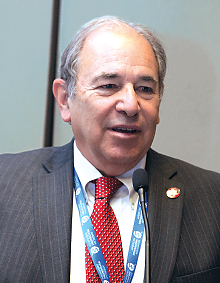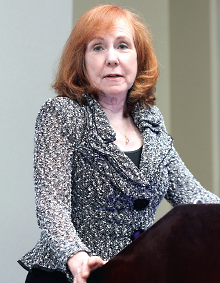Child Psychiatrists Look at Specialty From Both Macro, Micro Perspectives
Abstract
Big-picture approaches to system change and close attention to therapeutic detail can help improve the care of young patients.
Children are not just small adults, and clinical practice and the overall health care system need to take notice of that reality, said speakers at APA’s 2016 Annual Meeting in Atlanta in a session on child and adolescent psychiatry in the 21st century.

Because children’s brains are still malleable, modest investments in their present mental health pays off in the long run, according to Gregory Fritz, M.D.
Mental disorders are the most expensive elements of child health care, and changes under way in the American health care system may present opportunities for major improvements in care and cost, said Gregory Fritz, M.D., a professor and director of the Division of Child and Adolescent Psychiatry at Brown University’s Warren Alpert School of Medicine in Providence, R.I.
“Adults like to romanticize childhood and don’t understand the profundity of childhood mental illness,” said Fritz.
The keys to caring for children, he continued, lie in early recognition and treatment of their symptoms and integrating their care with care provided by pediatricians.
“Primary care is where the patients with mental disorders are,” said Fritz, president of the American Academy of Child and Adolescent Psychiatry. “There is a high level of trust, providers know the family better, and there is less stigma attached to a primary care visit.”
Unfortunately, the barriers to better care for children still amount to a “perfect negative system,” he said.
“Situational problems, developmental questions, and behavioral problems also can be important but are not diagnosable, and their treatment is thus not reimbursed,” he said. The traditional model of paying only for face-to-face care has impeded the adoption of integrated or collaborative care models in which psychiatrists serve in a consultative role.
He outlined other barriers as well. Mental health and primary care practitioners may be on different insurance panels and use different electronic health record systems. DSM and ICD diagnostic categories do not reflect lower levels of severity that require attention if early diagnosis and intervention are to be effective.
The time has come, said Fritz, to bring together federal and state agencies, insurers, and professional organizations to provide the big solutions to improving child mental health care: end fee-for-service payments, end mental health carveouts, enforce the 2008 parity law in combination with the Affordable Care Act, and better educate both primary care and mental health clinicians about new models of practice.

Parents' information about their children may be more useful when evaluating an adolescent patient for depression, says Karen Dineen Wagner, M.D., Ph.D.
In the clinic, managing mental illness in young people requires subtle but significant shifts in thinking, said Karen Dineen Wagner, M.D., Ph.D., a professor and chair of psychiatry and behavioral sciences at the University of Texas Medical Branch, Galveston. For instance, depression in children and adolescents presents differently from depression in adults and requires different approaches to evaluation and treatment, she said.
“Compared with adults, children with depression usually present more often with irritability than with sadness,” she said. Frequently, depression is comorbid with other problems common to young people, such as anxiety, ADHD, conduct disorder, substance use, or anorexia.
Screening can be done with the Mood Disorder Questionnaire–Adolescent, a modification of the PHQ-9. After some trial and error, Wagner and colleagues found that parents’ responses to the questionnaire were more useful than either the adolescents’ answers or an “attributional” form that asked teens what they thought their friends or teachers might be saying about them.
As for treatment, only two drugs are approved for use in youth by the Food and Drug Administration (FDA): fluoxetine for ages 8 to 17 and escitalopram for ages 12 to 17, said Wagner. “The youngest age in the clinical trials determines the lower end of the approved age range. So what do you do if an 11-year-old doesn’t respond to fluoxetine?”
One looks at other trials, she said, even if the FDA has not approved the drugs for pediatric use. For instance, one clinical trial found positive results for citalopram in ages 7 to 17, while two pooled trials of sertraline did so for ages 6 to 17.
Another issue with pediatric clinical trials is that 61 percent of youth respond to the drugs, but 50 percent respond to placebo, compared with 30 percent among adults, making it hard to separate effects.
When parents express anxiety about using SSRIs and ask for psychotherapy, Wagner explains that cognitive-behavioral therapy (CBT) takes time to work and that a faster response can be obtained by combining an antidepressant with CBT. CBT can teach social skills and problem-solving techniques as well. Wagner counsels patience once an SSRI is prescribed.
A 36-week trial of a drug is too brief, she said. “The clock starts when the child is well, usually around six months. Go for one year and then taper off to observe the effect.”
Wagner suggested using an algorithm to plot treatment, beginning with an SSRI, then trying an alternative SSRI if that doesn’t work, then switching to a different class of antidepressants, and finally trying newer drugs.
“We need to become much more systematic in treating depression,” she concluded. ■



